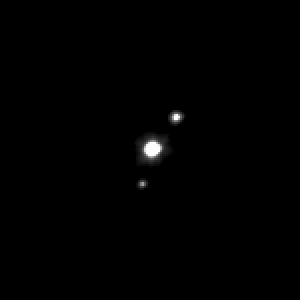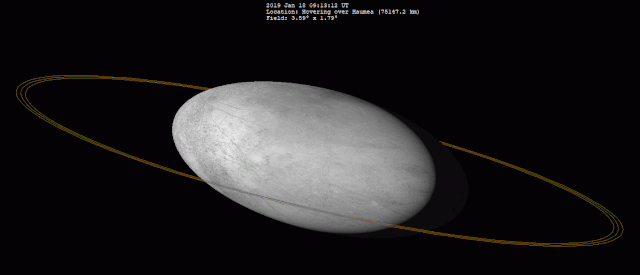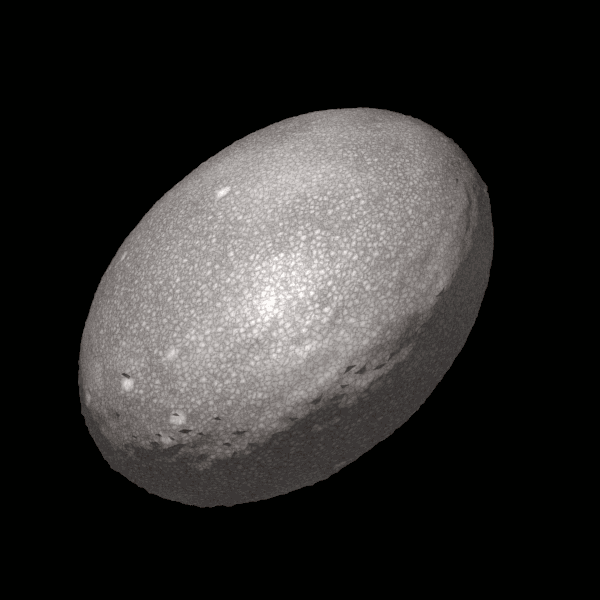Haumea is an intriguing and mysterious dwarf planet that lies in a far corner of the Solar System. This small and unique celestial body is a celestial object of great interest to astronomers and astrophysicists alike.
Dwarf planets are small, round, and icy objects that reside in our Solar System beyond the orbit of Neptune, and Haumea is no exception.
Introduction
Haumea is the fourth-largest known dwarf planet in the Solar System, and is one of the five officially recognized dwarf planets in the Solar System. It is the fourth-largest dwarf planet after Pluto, Eris and Makemake. It is also the second-most distant dwarf planet, after Eris. Haumea has an irregular shape due to its fast rotation, which is faster than any other known object in the Solar System.

Haumea is unique in that it is composed of a mixture of water ice and rock, lending it a reddish hue. Its surface consists of various features, such as craters and ridges, which may have been caused by impacts and other processes. There is evidence of a thin atmosphere surrounding Haumea, which may be composed of nitrogen, methane, and possibly carbon dioxide.
Haumea’s discovery is shrouded in mystery. Astronomers first spotted the unusual object in late 2004, but it was not officially recognized as a dwarf planet until September 17, 2008. The official name of Haumea, given by the International Astronomical Union, is Haumea or 136108 Haumea. In addition to its official name, it is also known by other nicknames, such as Santa, Hoemea, and Hiʻiaka.
Haumea’s orbit is fairly eccentric, and it is located in the Kuiper Belt. It is estimated that a year on Haumea is approximately 250 Earth years, and that its orbital period is 284 Earth years. Its orbital eccentricity is 0.19, which is the highest of any known Solar System object.
Haumea is a fascinating object, and its potential habitability is a topic of much debate and speculation. Although the conditions on the surface of Haumea are likely too extreme and hostile for any form of known life, some scientists speculate that there may be a possibility of life existing in subsurface oceans.
Haumea is a compelling celestial body that has scientists and amateur astronomers alike captivated. In this article, we will explore the definition of a dwarf planet, its unique characteristics, composition, discovery, orbit, naming, and potential habitability. We will then summarize its significance in the Solar System.
Unique Characteristics
Haumea, discovered in 2004, is one of the five officially recognized dwarf planets in the Solar System, the most distant of which is classified as a trans-Neptunian object. Its unique characteristics make it particularly fascinating when compared to other dwarf planets.
At its widest point, Haumea is 1,468 kilometers in diameter, making it approximately one-third the size of Pluto, and placed at the farthest reaches of the Solar System, it is highly unique in its shape. It has a triaxial ellipsoid shape, with its long and narrow axis measuring approximately 1,180 kilometers, its medium axis measuring 960 kilometers, and its short axis measuring 820 kilometers. It’s an elongated, egg-shaped figure, with two lobes, one larger than the other.
The rotational period of Haumea is incredibly fast, at only 3.9 hours, making it the fastest-spinning planet in our Solar System, and the second-fastest spinning large body in the Solar System after Jupiter’s moon, Io. The shape of Haumea is thought to be the result of this rapid rotation, as it has an irregular shape and is one of the most distinct dwarf planets.
In addition to this, Haumea has two known moons, Hi’aka and Namaka, which are thought to have been formed from a collision that occurred about 4 billion years ago. Hi’aka is the larger of the two, measuring approximately 183 kilometers in diameter, while Namaka is approximately 87 kilometers in diameter.
The surface of Haumea is a mix of frozen water, methane, and nitrogen ices, and is believed to be relatively smooth and featureless, with no visible craters. This is due to its extremely fast rotation, which is thought to be enough to cause any craters formed by impacts to be covered up by new material. The color of the surface is believed to be a dull red-brown, as observed from the Hubble Space Telescope.
Haumea is one of the most unique and intriguing of the dwarf planets, with an unusual shape and incredibly fast rotation, along with two moons and a unique surface composition. Its unique characteristics make it worth studying, and its discovery has piqued the interest of astronomers around the world.
Composition
Haumea is a dwarf planet composed mainly of rock and ice. Its composition is believed to be made up of silicates, water ice, and methane ice. The silicates are believed to make up the majority of its composition, while the water ice and methane ice are believed to make up the remaining materials.
The size and shape of Haumea are quite unique. It is one of the largest objects in the Kuiper belt, and its shape is quite unusual. It is shaped like a rugby ball, and is about 1,400 kilometers long and 800 kilometers wide. It is much bigger than other Kuiper belt objects, such as Pluto and Makemake. Haumea’s rotational period is relatively short, just 4.1 hours, making it one of the fastest spinning objects in the Solar System.
Another interesting feature of Haumea is its number of moons. Unlike most other dwarf planets, Haumea has two moons, named Hi’iaka and Namaka. It is believed that these moons were formed by a collision between Haumea and another Kuiper belt object.
The surface of Haumea is covered with relatively fresh ice, which gives it a very bright, white appearance. The ice is believed to be made up of water ice, methane ice, and carbon dioxide ice. The ice on Haumea’s surface is reflective and keeps it relatively warm, which is why it has been able to maintain its icy surface over billions of years.
The composition of Haumea also includes a large amount of ammonia, which is believed to be in the form of hydrated ammonia. It is believed that this ammonia was brought to the surface by a collision between Haumea and another Kuiper belt object. This collision also created Haumea’s two moons, Hi’iaka and Namaka.

Discovery
The discovery of Haumea, a unique and intriguing dwarf planet, has been a captivating story. Haumea was first identified in December of 2004 by a team of astronomers at the Palomar Observatory in California. The team was led by Mike Brown, who is now known as the “Pluto Killer” for his discovery of various objects in the trans-Neptunian region that were eventually classified as dwarf planets. The team initially referred to the object as 2003 EL61, and it was not until September 2005 that the International Astronomical Union (IAU) approved the name Haumea.
Haumea is located in the outer region of the Solar System, within the Kuiper Belt. At the time of its discovery, it was the first trans-Neptunian object to be classified as a dwarf planet. Haumea has since become one of the most intriguing and studied objects of its kind. This is in part due to its unique and captivating characteristics.
Haumea is an extreme object that has some unusual properties. The first and most obvious is its shape, which is highly elongated. It has a length of approximately 870 miles and a width of 535 miles, making it more oval in shape than a perfect sphere. It also has a very short rotational period of only 4 hours and 10 minutes, making it one of the fastest rotating objects in the Solar System. Haumea is also home to two moons, Hi’iaka and Namaka, both of which were discovered in 2005.
The composition of Haumea is also intriguing. It is made up mostly of rock and ice in a nearly equal proportion. The surface of Haumea is covered in a layer of water-ice, which is thought to be the result of icy volcanism. Additionally, a variety of minerals have been detected on the surface, including quartz, olivines, and clays.
The story of Haumea’s discovery is a fascinating one. It was not until the early 21st century that astronomers were able to identify and classify this unique dwarf planet. Since then, Haumea has become a source of much intrigue and research because of its unusual characteristics. It is a fascinating object in the Solar System that deserves to be studied and explored.
Orbit
Haumea is one of the five dwarf planets recognized by the International Astronomical Union and is classified as a plutoid. As such, it has an orbit around the sun that is more eccentric than that of other planets. Its orbit around the sun is highly inclined with respect to the ecliptic, meaning that it is not in the same plane as most other planets.
Haumea orbits around the sun in a highly elliptical shape with an orbital period of 284 Earth years. Its eccentricity of 0.19 indicates that it does not trace a perfect circle around the sun. The most distant point of its orbit from the sun is 49.2 AU, which is almost the same distance between Neptune and the sun. Its perihelion, or closest point to the sun, is 30.3 AU which is just beyond the orbit of Saturn.
Haumea’s orbital inclination is 28.2° which is higher than any other dwarf planet. This means that it is not in the same plane as most other planets. Due to its high inclination, Haumea occasionally passes close to the orbit of Neptune, though its closest approach is still well outside Neptune’s orbit.
The orbit of Haumea is also affected by its two moons, Hiʻiaka and Namaka. Hiʻiaka has a much larger mass than Namaka, so it exerts a much stronger gravitational pull on Haumea than Namaka. This causes Haumea’s orbit to become slightly oblate and precess over time. The interaction between Haumea and its moons also affects the orbits of the moons themselves, causing them to precess and potentially become unstable over time.
Haumea’s orbit is a very unusual one by Solar System standards, making it an intriguing object to study. It is a unique object in the Solar System that provides insight into the formation and evolution of the Kuiper belt. Its highly inclined orbit and close encounters with Neptune indicate that it likely had a complex history of interactions with other objects in the Kuiper belt.
Naming
The naming of Haumea is an interesting story. The dwarf planet is named after the Hawaiian goddess of fertility and childbirth, Haumea. After being discovered in 2004, the name Haumea was proposed and officially accepted by the International Astronomical Union in September 2008.
The naming of Haumea was made possible by a team of scientists from the Spanish Institute of Astrophysics, led by José Luis Ortiz. The team named the dwarf planet in honor of the mother of the Hawaiian gods, the goddess Haumea.
Haumea is also known by other names, such as “Santa” and “Eris”. Santa is derived from the Spanish word “santa” meaning “saint” and was given to the dwarf planet by Ortiz’s team in reference to the Spanish term “Santa Claus”. Eris is a name given to the dwarf planet by its discoverer, Mike Brown, in reference to the goddess of discord and strife in Greek mythology.
The official name “Haumea” was chosen for the dwarf planet after a debate between the discoverers of Haumea and the International Astronomical Union. The name was proposed to the IAU in December 2005 and officially accepted in September 2008.
Haumea is also known by other names, such as “Hi’iaka,” after the daughter of Haumea, and “Makemake,” after the chief god of the Easter Islanders. Haumea is also known as a nickname by its discoverers, “Santa” or “Eris”.
In 2015, the IAU also approved the names of two of Haumea’s moons, Hi’iaka and Namaka. Hi’iaka was named after Haumea’s daughter, Hi’iaka, and Namaka was named after Haumea’s granddaughter, Namaka.
The naming of Haumea and its moons is an interesting and intriguing story. It speaks to the mythological and cultural importance of the Hawaiian goddess, Haumea. The names of the moons, Hi’iaka and Namaka, also capture the importance of family in Hawaiian mythology.

Data
| Discovery | |
|---|---|
| Discovered by |
|
| Discovery date |
|
| Designations | |
|
MPC designation
|
(136108) Haumea |
| Pronunciation | /haʊˈmeɪ.ə, ˌhɑːuː-/ |
|
Named after
|
Haumea |
|
Alternative designations
|
2003 EL61 |
|
Minor planet category
|
|
| Adjectives | Haumean |
| Orbital characteristics | |
| Epoch 17 December 2020 (JD 2459200.5) | |
| Uncertainty parameter 2 | |
| Observation arc | 65 years and 291 days (24033 days) |
| Earliest precovery date | March 22, 1955 |
| Aphelion | 51.585 AU (7.7170 Tm) |
| Perihelion | 34.647 AU (5.1831 Tm) |
|
Semi-major axis
|
43.116 AU (6.4501 Tm) |
| Eccentricity | 0.19642 |
|
Orbital period (sidereal)
|
283.12 yr (103,410 days) |
|
Average orbital speed
|
4.53 km/s |
|
Mean anomaly
|
218.205° |
|
Mean motion
|
0° 0m 12.533s / day |
| Inclination | 28.2137° |
|
Longitude of ascending node
|
122.167° |
|
Time of perihelion
|
≈ 1 June 2133 ±2 days |
|
Argument of perihelion
|
239.041° |
| Known satellites | 2 (Hiʻiaka and Namaka) |
| Physical characteristics | |
| Dimensions |
|
|
Mean radius
|
|
|
Surface area
|
≈ 8.14×106 km2 |
| Volume | ≈ 1.98×109 km3 0.0018 Earths |
| Mass | (4.006±0.040)×1021 kg 0.00066 Earths |
|
Mean density
|
|
|
Equatorial surface gravity
|
0.93 m/s2 at poles to 0.24 m/s2 at longest axis |
|
Equatorial escape velocity
|
1 km/s at poles to 0.71 km/s at longest axis |
|
Sidereal rotation period
|
3.915341±0.000005 h (0.163139208 d) |
|
Axial tilt
|
≈ 126° (to orbit; assumed) 81.2° or 78.9° (to ecliptic) |
|
North pole right ascension
|
282.6°±1.2°: 3174 |
|
North pole declination
|
−13.0°±1.3° or −11.8°±1.2°: 3174 |
|
Geometric albedo
|
|
| Temperature | < 50 K |
|
Spectral type
|
|
|
Apparent magnitude
|
17.3 (opposition) |
|
Absolute magnitude (H)
|
0.428±0.011 (V-band) · 0.2 |
